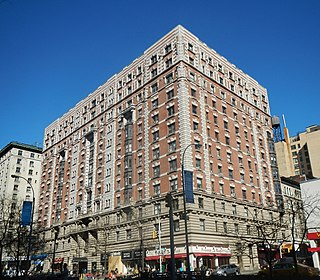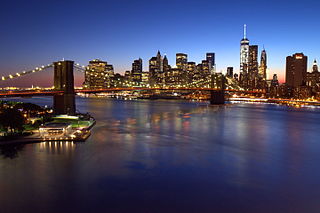
The Woolworth Building is an early American skyscraper located at 233 Broadway in Manhattan, New York City. Designed by architect Cass Gilbert, it was the tallest building in the world from 1913 to 1930, with a height of 792 feet (241 m). More than a century after its construction, it remains one of the 100 tallest buildings in the United States as well as one of the 30 tallest buildings in New York City.

Broad Street is a narrow street located in the Financial District in the New York City borough of Manhattan. It stretches from South Street to Wall Street.

In retail, an "anchor tenant", sometimes called an "anchor store", "draw tenant", or "key tenant", is a considerably larger tenant in a shopping mall, often a department store or retail chain. With their broad appeal, they are intended to attract a significant cross-section of the shopping public to the center. They are often offered steep discounts on rent in exchange for signing long-term leases in order to provide steady cash flows for the mall owners.
The Weylin Hotel was a hotel at 527 - 531 Madison Avenue and 40 - 54 East 54th Street in New York City. It was on the southeast corner of 54th Street. The structure was sixteen stories tall and opened in March 1921. The building fronted sixty-one feet on Madison Avenue and one hundred forty-eight feet on 54th Street. It contained 125,000 square feet (11,600 m2) of space.

The Marbridge Building is an office establishment located at 1328 Broadway between 34th and 35th Streets, on the east side of Herald Square, Manhattan, New York City. It opened in 1909, an 11-story building, utilized in part by Rogers Peet. Until October 1910 it stood opposite the Alpine apartment house, which was at the northeast corner of Broadway and 33rd Street. The Alpine and old stores between 33rd and 34th Streets were demolished to make room for the $5,000,000 Hotel McAlpin near the end of 1910. On the other side of Broadway were located the Macy's and Saks Incorporated stores, with the Gimbels store just below.
The Studebaker Building is a former structure at 1600 Broadway on the northeast corner at 48th Street. It was erected by the Juilliard Estate, in 1902, between Broadway and 7th Avenue, in the area north of Times Square. It was demolished in 2004 to make room for an apartment tower, a twenty- five story, 136 unit, luxury condominium designed by architect Einhorn Yaffee Prescott.

Bretton Hall is a twelve-story residential building at 2350 Broadway, spanning from West 85th to 86th streets on the Upper West Side of Manhattan, New York City.
The Silk Centre was an area of business property, composed of buildings and lofts, which opened in Manhattan, in 1924. It was adjacent to a car-barn site, numerous clothing firms, and advertising agents located within a block or two of this corner. Harper & Brothers was also situated on East 33rd Street.
The Gunther Building was a seven-story commercial edifice in Manhattan located at 391 - 393 Fifth Avenue, between 36th Street and 37th Street. It occupied a plot 41.8 feet (12.7 m) on Fifth Avenue by 111.8 feet (34.1 m) in depth. Built in 1909, the establishment conformed in architecture, appointments, and construction with the Tiffany and Company Building, which adjoined it. The latter structure was designed by Stanford White and was constructed by Tiffany & Company in 1903, at the corner of the block on 37th Street.

The Mortimer Building was a 19th-century edifice located at Wall Street and New Street. It was built by W.Y. Mortimer beginning on June 1, 1884, and completed for occupancy in March 1885. The architect was George B. Post. It fronted Wall Street for a distance of fifty-seven feet and New Street for sixty-five feet. Used entirely as an office building, the structure adjoined the stock exchange building on the west and south. Tenants included lawyers, brokers, and bankers.
Legnam Corporation operated 132 general merchandise stores in 38 of the United States prior to becoming insolvent in June 1932. It sold ladies' apparel. Owing to the financial crisis during the Great Depression, the chain store, formerly known as Mangel's, became unable to pay its debts. The company maintained offices at 1115 Broadway and 226 Main Street in Paterson, New Jersey.
The Haas Building is located at 219 West 7th Street, at the corner of Broadway and Seventh Street, in Historic Downtown Los Angeles, California. The building was originally owned by Abraham Haas of San Francisco; president of Haas, Baruch,CXL & PWL'S. The structure was made to be one of the finest and most modern buildings of the time. The building was constructed in the year 1915, built with the latest steel frame and absolutely fireproof. Architectural firm Morgan, Walls & Clements designed this 12-story terra cotta business structure attractively facing the street with a frontage of 55 feet (17 m) on Broadway by 150 feet (46 m) on Seventh. The building was 50 by 75 feet (23 m) on the ground floor as well as the basement. The Haas Building was completed early 1915.

The Mills Building was a 10-story structure that stood at 15 Broad Street and Exchange Place in Manhattan, with an L to 35 Wall Street. It adjoined the building that was the home of Equitable Trust Company. It also adjoined the J. P. Morgan & Company Building on both Broad and Wall streets. George B. Post was the architect of the edifice.
Hills Supermarkets, owned by H. Frederick Hill, was a New York based grocery store chain which was popular in the 1960s. In May 1977 it was sold as a subdivision of Pueblo International Inc., to Food Fair.
Kemble Building was an eight story edifice located at 15 - 25 Whitehall Street between Bridge Street and Stone Street (Manhattan). It stood opposite the Custom House in Manhattan, New York. Owned by the Ogden Goelet Estate, the structure adjoined the seven story Produce Exchange Building. At first employed as a cotton warehouse, it was used for office space beginning in 1882. Prior to the Kemble Building's erection, the site was occupied by the business of Hendrick Willemsen, a baker and bread inspector.
Virginia Dare Dresses, Incorporated operated a chain of retail stores in New York City. Based at 462 7th Avenue (Manhattan), the company became a casualty of the Great Depression. In March 1933 it went into receivership, with a court-appointed receiver being named. In October 1934 the business emerged from financial difficulty and leased 10,000 square feet (930 m2) of space in the Penn Terminal Building at 370 7th Avenue. Philip Wise, another women's wear chain, and Wheelan Studios, rented property in the same building. The re-emergent organization was known as Virginia Dare Stores, Inc. It is important for having survived in a turbulent economic time in United States history.

William Wheeler Smith, AIA, professionally known as "W. Wheeler Smith," was an American architect and developer active in late-nineteenth- and early-twentieth-century New York City. His home office was located at 17 East 77th Street, New York City. He previously occupied 971 Madison Avenue.
Wallachs (Clothiers) was a New York City men's clothing chain store which once maintained additional locations in Newark, New Jersey, Brooklyn, New York, Jamaica, Queens, and Flushing, New York. It was a New York institution for more than a century. Together with Roots and F.R. Tripler, Wallachs was part of a nineteen state chain of fifty stores controlled by the Hastings Group. Hastings Group filed for Chapter 11 bankruptcy in November 1995.
Fair Waist and Dress Company was an early 20th-century women's apparel establishment, founded in 1909, located at 1372 - 1378 Broadway (Manhattan). It was situated at the corner of 32nd Street.
Rutley's, Inc. was a 1930s restaurant located at 1440 Broadway. It was a casualty of the Great Depression, remaining solvent but coming up short of its existing obligations in February 1932. A receiver, Richard M. Page, was appointed by New York District Court judge Goddard, under $10,000 bond, on February 15, 1932.













